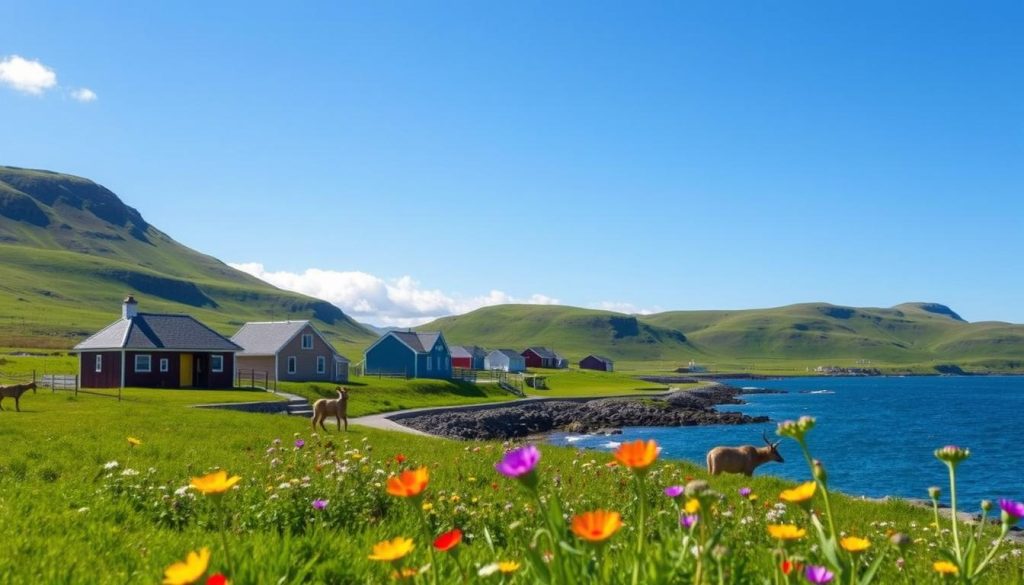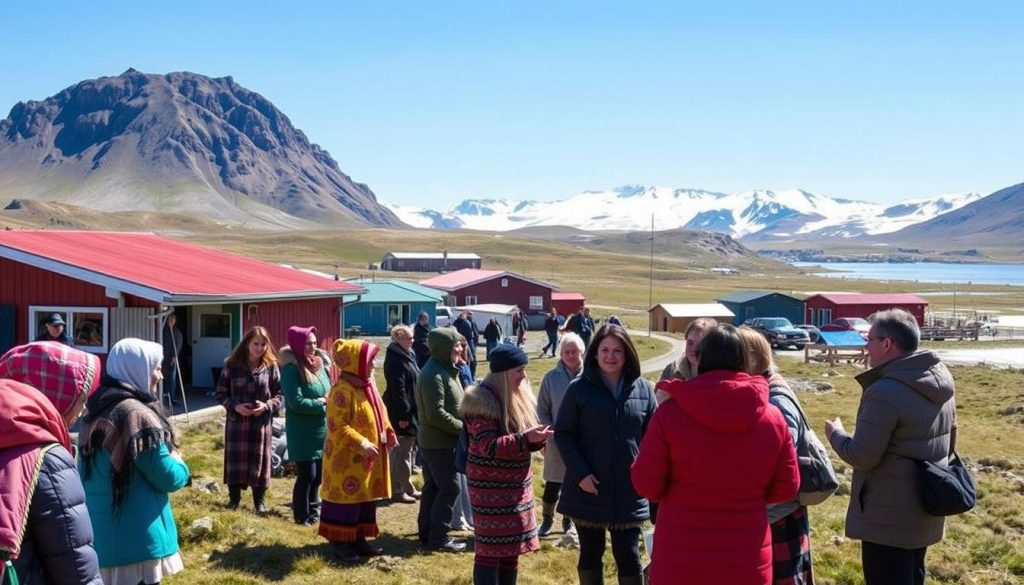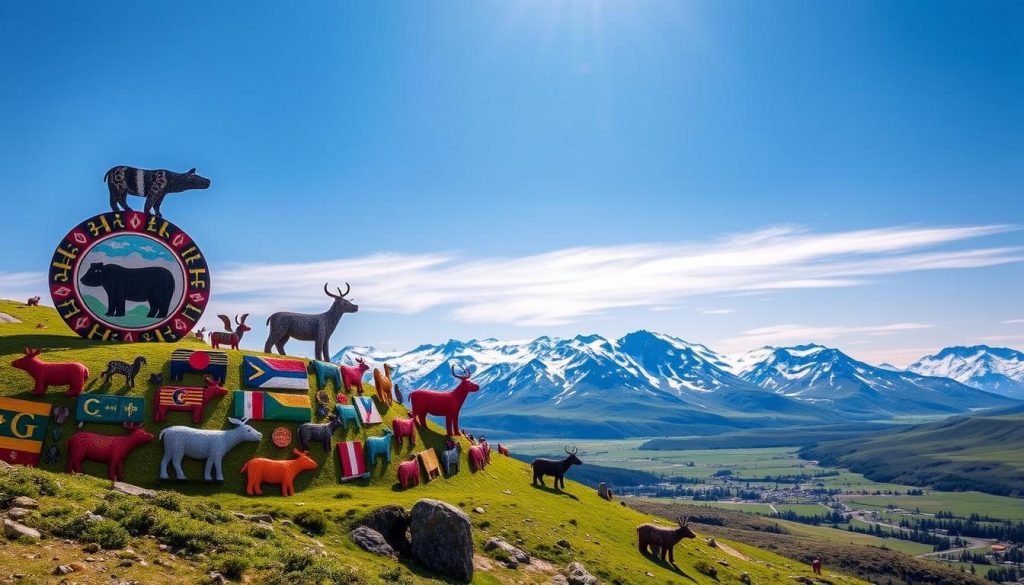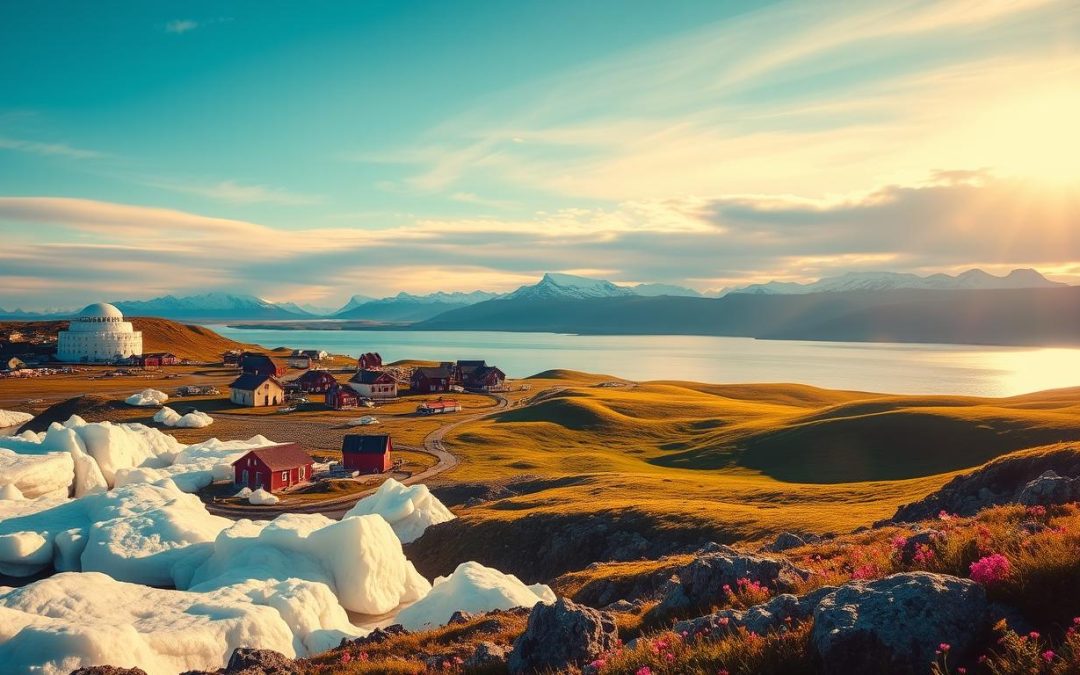Have you ever thought about how a small Arctic nation keeps its language alive in today’s world? Greenland’s story of language is both inspiring and complex.
Located in the icy North Atlantic, Greenland is a place of rich culture and language. The official language, Greenlandic or Kalaallisut, is spoken by about 50,000 people. This language is a key part of Greenland’s identity.
Almost 85-90% of Greenlanders speak Greenlandic. It’s more than just a way to talk; it’s a symbol of who they are. The language mix in Greenland includes indigenous dialects, colonial influences, and global connections.
Key Takeaways
- Greenlandic is the official language of Greenland
- Over 85% of the population speaks Greenlandic
- Multiple dialects exist, with Kalaallisut being the most widespread
- Danish remains a significant second language
- Language preservation is crucial to cultural identity
Introduction to Linguistic Landscape in Greenland
Exploring Greenland’s language scene reveals a rich mix of indigenous tongues and cultural exchanges. This Arctic territory, despite its remote location, boasts a surprising linguistic diversity.
At the heart of Greenland’s language heritage is Greenlandic (Kalaallisut). It belongs to the Eskimo-Aleut family. Greenland’s small population belies its linguistic complexity.
“Language is the roadmap of a culture. It tells you where its people come from and where they are going.” – Rita Mae Brown
Key aspects of Greenland’s language scene include:
- West Greenlandic is the standard dialect
- Bilingualism is common among locals
- Danish is also a key language
- English is becoming more popular among the young
The linguistic diversity in Greenland mirrors its rich cultural past. Different languages mark various settlement and colonization periods. Indigenous languages are vital for keeping cultural identity and traditional knowledge alive.
| Language | Speakers | Status |
|---|---|---|
| Greenlandic (Kalaallisut) | Approximately 50,000 | Official Language |
| Danish | Around 12% of population | Administrative Language |
| English | Growing among youth | Emerging Communication Language |
Traveling through Greenland’s language landscape shows a dynamic mix. Here, indigenous languages meet colonial and global tongues. This creates a lively and unique linguistic world.
Historical Development of Languages in Greenland
Greenland’s language history is a story of cultural mix and change. It shows how indigenous languages, Danish, and cultural efforts have shaped the island’s speech.
Pre-Colonial Language Foundations
Before Europeans arrived, Greenland’s languages were rich and diverse. The Thule people, who are the ancestors of today’s Inuit, came from Alaska around 1200 AD. They brought their language with them.
Greenlandic became a complex language. It could make detailed words by combining different parts.
- Approximately 57,000 people speak Greenlandic
- 14 total dialects in the Inuit language group
- 3 specific dialects existing in Greenland
Impact of Danish Colonization
Danish missionaries were key in learning about Greenlandic. By 1760, Paul Egede had written the first detailed study of Greenlandic sounds. This started a big change in how Danish and Greenlandic languages interacted.
“Language is the roadmap of a culture. It tells you where its people come from and where they are going.” – Rita Mae Brown
Language Evolution Post-1953
The 1953 Danish constitution changed Greenland’s language rules a lot. It made Danish more common in many areas but also kept Greenlandic language alive.
| Language | Speakers | Usage Context |
|---|---|---|
| Greenlandic | 85% of population | Primary communication |
| Danish | 50% of population | Official and administrative |
| English | Limited | Tourism sector |

Now, Greenland has a special mix of languages. Danish and minority languages live together, showing the island’s rich culture and ongoing language changes.
Greenlandic: The Official Language Status
In June 2009, Greenland made a historic decision. Greenlandic, known as Kalaallisut, became the sole official language. This marked a significant milestone in cultural preservation and national pride.
The official language status is more than a legal term. It’s a powerful statement of cultural identity and linguistic sovereignty for Greenlandic people. With about 57,000 native speakers, Greenlandic shows the resilience of an indigenous language in today’s world.
“Language is the roadmap of a culture. It tells you where its people come from and where they are going.” – Rita Mae Brown
- West Greenlandic (Kalaallisut) serves as the standard dialect
- The language boasts a remarkable 100% literacy rate
- Recognized by UNESCO as a “Vulnerable” language
This change wasn’t just about legal recognition. It was a deeper commitment to preserving Greenlandic culture and empowering local communities. The move ensured Kalaallisut would be used in government, education, and public communication. This protects its vitality for future generations.
Understanding Greenlandic’s official status shows the deep connection between language and cultural identity. It’s a powerful example of how a community can reclaim and celebrate its linguistic heritage in today’s world.
Kalaallisut: The Main Dialect of Greenlandic
Explore the world of Greenlandic languages, where Kalaallisut is the main language. It’s a complex indigenous language at the heart of Greenland’s diversity.

About 88% of Greenland’s people speak Kalaallisut. It’s more than a language; it’s a key part of their culture. Around 50,000 people use it, keeping Greenland’s heritage alive.
West Greenlandic Features
West Greenlandic, or standard Kalaallisut, has unique features. Its complex grammar lets people form words that mean whole sentences.
- Polysynthetic language structure
- Extensive use of verb modifications
- Rich system of grammatical cases
Regional Variations
Greenland has three main dialect groups, each with its own traits:
| Dialect | Region | Unique Characteristics |
|---|---|---|
| Kalaallisut | West Greenland | Standard form, most widely spoken |
| Tunumiit | East Greenland | Distinct phonological variations |
| Avanersuarmiutut | North Greenland | Smallest dialect group |
Written and Spoken Forms
The written form of Kalaallisut was modernized in 1973. This made it easier to use. The spoken language stays true to tradition, but the written form keeps changing.
“Language is the road map of a culture. It tells you where its people come from and where they are going.” – Rita Mae Brown
Learning Kalaallisut helps us see how indigenous languages keep culture alive. They connect communities across Greenland’s varied landscape.
Danish Language Role and Influence
In Greenland, the Danish language has a strong and complex role. Even though Greenlandic is the official language, Danish is key in many areas. This includes education, work, and society.
The history between Danish and Greenlandic shows a deep colonial past. Since 1953, Danish has been a focus in schools. It also leads in many parts of Greenlandic society.
- Educational importance in bilingual learning
- Professional communication channels
- Media and cultural transmission
- Administrative and governmental operations
Greenland’s way with minority languages is advanced. About 50,000 Danes in Greenland speak Danish as their main language. This makes for a special multilingual setting.
“Language is the roadmap of a culture. It tells you where its people come from and where they are going.” – Rita Mae Brown
| Language Characteristic | Danish in Greenland |
|---|---|
| Official Status | Recognized minority language |
| Educational Role | Second language instruction |
| Professional Importance | High level of communication |
| Cultural Influence | Significant media presence |
Understanding Danish’s role in Greenland shows the country’s rich language heritage. It connects Greenland’s traditional culture with the world today.
Modern Language Distribution and Demographics

Greenland’s language scene is a mix of old traditions and new ways of living. With only 57,792 people, it’s a special place for many languages. This is true for both city and countryside.
About 70% of the people speak Greenlandic as their main language. This helps keep their culture and identity strong.
Urban and Rural Language Patterns
Language use changes a lot between cities and towns:
- In cities like Nuuk, more people speak many languages.
- In rural areas, people stick to traditional Greenlandic.
- City folks (87.8%) get to hear and speak more languages.
Age-Related Language Dynamics
Age affects how people use and learn languages:
- Young people are getting better at speaking two languages.
- Older folks mostly speak Greenlandic.
- Schools work hard to teach many languages.
“Language is the roadmap of a culture. It tells you where its people come from and where they are going.” – Rita Mae Brown
There’s a careful plan to keep Greenlandic alive while also learning other languages. This shows a deep respect for their culture and openness to the world.
Language Education System in Greenland
Greenland’s education system is shaped by its cultural identity and history. Since 1979, Greenlandic has been the main language taught in schools.
The education in Greenland is special because it’s multilingual. Students learn:
- Greenlandic (Kalaallisut) as the main language
- Danish as a secondary language
- English as a foreign language
In early school years, Greenlandic is used most in class. By upper secondary school, Danish becomes the main teaching language. This mix of languages makes learning a challenge for students.
“Education is the cornerstone of cultural preservation and linguistic identity” – Greenlandic Education Policy
The education system tackles big challenges:
- Keeping indigenous language skills alive
- Teaching students to communicate globally
- Keeping cultural heritage through language
| Education Level | Primary Language | Secondary Language |
|---|---|---|
| Primary School | Greenlandic | Danish |
| Secondary School | Danish | English |
| Higher Education | Danish/English | Greenlandic |
Despite a high dropout rate in higher education, Greenland keeps working on its language education. It aims to keep traditional languages alive while teaching global communication skills.
English and Other Foreign Languages
Greenland is growing its ties to the world, making English and other foreign languages more important. The island’s language scene shows a mix of many languages and cultural sharing.

Business Communication Trends
English is key for international business in Greenland. People see the value of speaking many languages to succeed globally. Important points about English in business include:
- Mandatory English education starting from the first school year
- Growing emphasis on English skills for international trade
- Increased communication with global partners
Tourism Language Dynamics
The tourism industry has made English more needed. Greenland’s special culture draws visitors from around the world. This leads to more chances for people to talk in different languages.
“Language is the roadmap of a culture. It tells you where its people come from and where they are going.” – Rita Mae Brown
While Greenlandic and Danish are still common, other languages are also heard because of people moving here. These include:
- Icelandic
- Filipino
- Swedish
- Norwegian
- Thai
- French
About 80% of Greenland’s people can speak more than one language. Most speak two or three. This shows the island’s rich culture and ability to adapt to the world.
Language Rights and Political Implications
Language rights in Greenland are key to preserving culture and asserting political power. The indigenous languages of Greenland are more than just ways to communicate. They are powerful symbols of national identity and the right to self-determination.
The language policy in Greenland has changed a lot, especially after the 2009 Self-Government Act. This important law made Kalaallisut the only official language. It was a big step for indigenous languages in the area.
“Language is the roadmap of a culture. It tells you where its people come from and where they are going.” – Rita Mae Brown
- Kalaallisut became the main language for government work
- More public services are now in indigenous languages
- Political leaders now focus more on speaking the language
Language rights have big political meanings. They are not just about recognizing culture. They are a way to keep cultural identity strong and challenge old colonial stories.
| Language Policy Milestone | Year | Significance |
|---|---|---|
| Self-Government Act | 2009 | Kalaallisut declared official language |
| Parliamentary Representation | 1953 | First guaranteed seats for Greenlandic representatives |
Understanding Greenland’s language scene shows a deep commitment to keeping minority and indigenous cultures alive. The ongoing fight for language rights is helping Greenland move towards more freedom.
Cultural Identity Through Language
Language is at the heart of cultural identity, especially in Greenland. The Greenlandic language connects generations, keeping traditional knowledge alive. It also lets people express their culture in new ways. As an indigenous language, it holds the Inuit heritage.
Understanding Greenlandic language shows a rich cultural scene. It links old wisdom with today’s experiences. This shows the strength of indigenous communities.
Preserving Traditional Knowledge
Traditional knowledge is passed through Greenlandic language. It includes:
- Oral storytelling traditions
- Transmission of hunting and fishing techniques
- Environmental understanding passed through generations
- Spiritual and cultural practices embedded in language
Modern Cultural Expression
Young Greenlanders are using language in new ways. They create:
- Contemporary art incorporating indigenous themes
- Music blending traditional and modern styles
- Literature exploring complex cultural experiences
- Digital media promoting linguistic diversity
“Our language is our soul, connecting past and present.” – Anonymous Greenlandic Cultural Leader
The Greenlandic language keeps evolving. It remains key to preserving culture and shaping identity.
Current Language Challenges and Future Perspectives
Greenland’s language scene is facing big challenges. It’s trying to keep its rich language heritage alive. The current language policy deals with the complex mix of languages and cultural changes.
UNESCO is worried about endangered Greenlandic dialects, like the Eastern Greenlandic one. Fewer people are speaking it, which is a big risk for the language’s future.
- Approximately 88% of the population speaks Greenlandic
- Fluent speakers are decreasing by 1.5% annually since 2000
- English is gaining prominence among younger generations
The National Greenlandic Language Board is working hard to save the language. They have a budget of 1.2 million DKK each year. They’re making plans to keep the language alive.
“Language is the roadmap of a culture. It tells you where its people come from and where they are going.” – Rita Mae Brown
Looking ahead, there are a few important steps for Greenlandic language:
- Improving education in Greenlandic
- Helping pass the language down to younger generations
- Creating digital tools for learning the language
| Language Challenge | Potential Solution |
|---|---|
| Declining Native Speakers | Intensive Language Revitalization Programs |
| Limited Digital Resources | Technology-Enhanced Learning Platforms |
| Generational Language Shift | Community Engagement Initiatives |
Understanding these challenges is key to helping Greenland keep its culture alive.
Conclusion
Exploring Greenland’s language scene reveals a rich mix of communication. At its core is Greenlandic, a key part of the Inuit culture that makes up 89.51% of the population. This shows how Greenland balances keeping traditional languages alive with the need to communicate globally.
The story of Greenland’s languages is one of strength and change. You’ll find Kalaallisut, Danish, and English all playing important roles. Each language adds a piece to the country’s history and culture. This shows how a small population of 56,583 people keeps their language scene vibrant and diverse.
Greenland’s language policy shows a strong dedication to its culture and the world. The mix of Greenlandic, Danish, and new languages shows the country’s unique place in the world. Reflecting on this, you’ll see that language is more than just talking. It’s a living part of Greenland’s identity, showing its strength and ongoing growth.
The above is subject to change.
Check back often to TRAVEL.COM for the latest travel tips and deals.
Here are some Tours & Sightseeing suggestions that might pique your interests!
